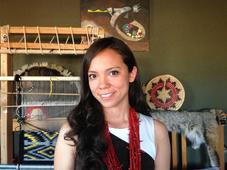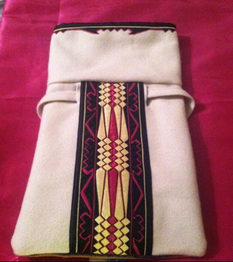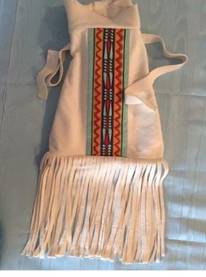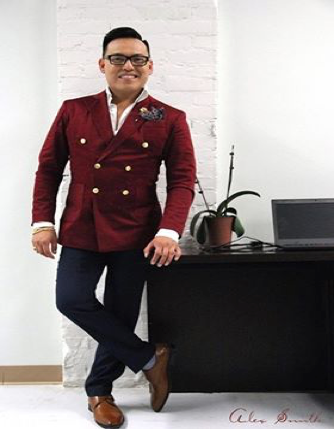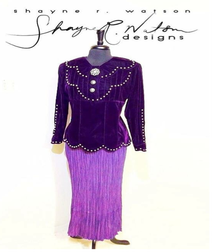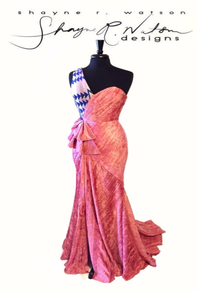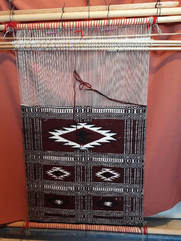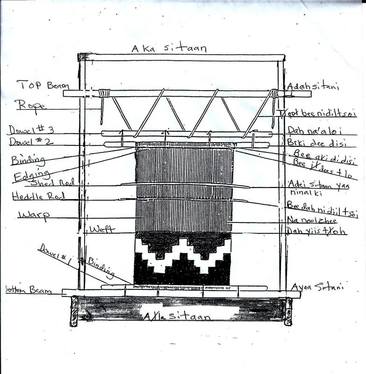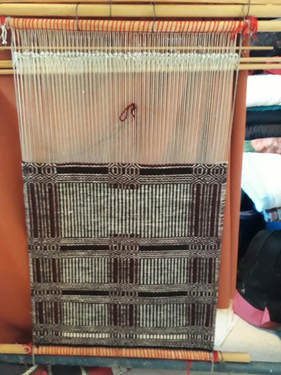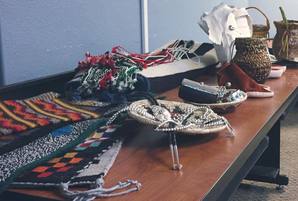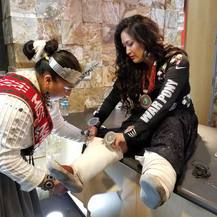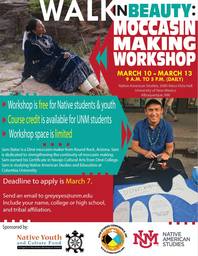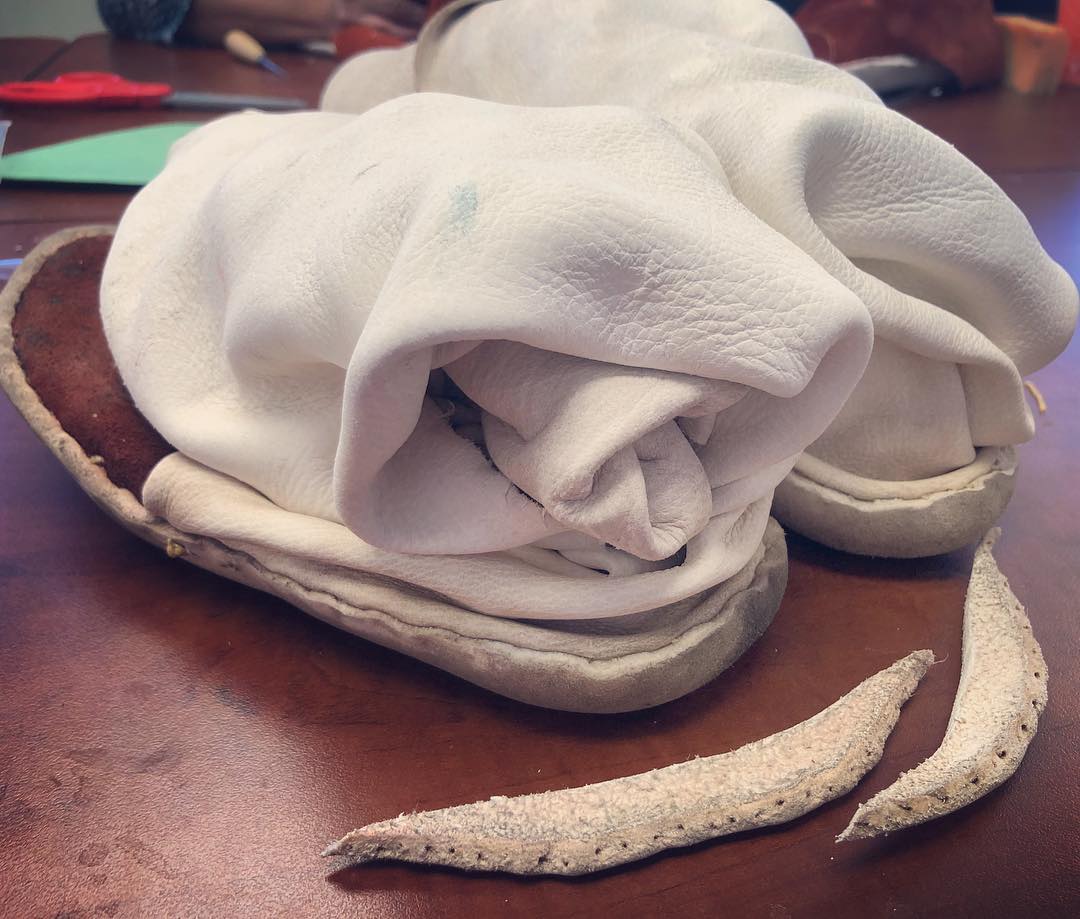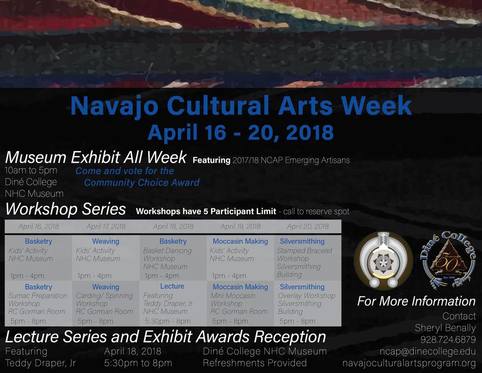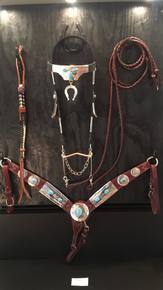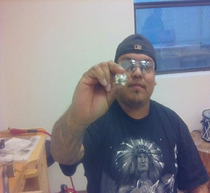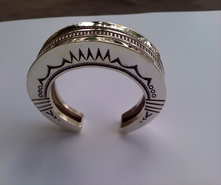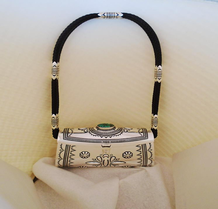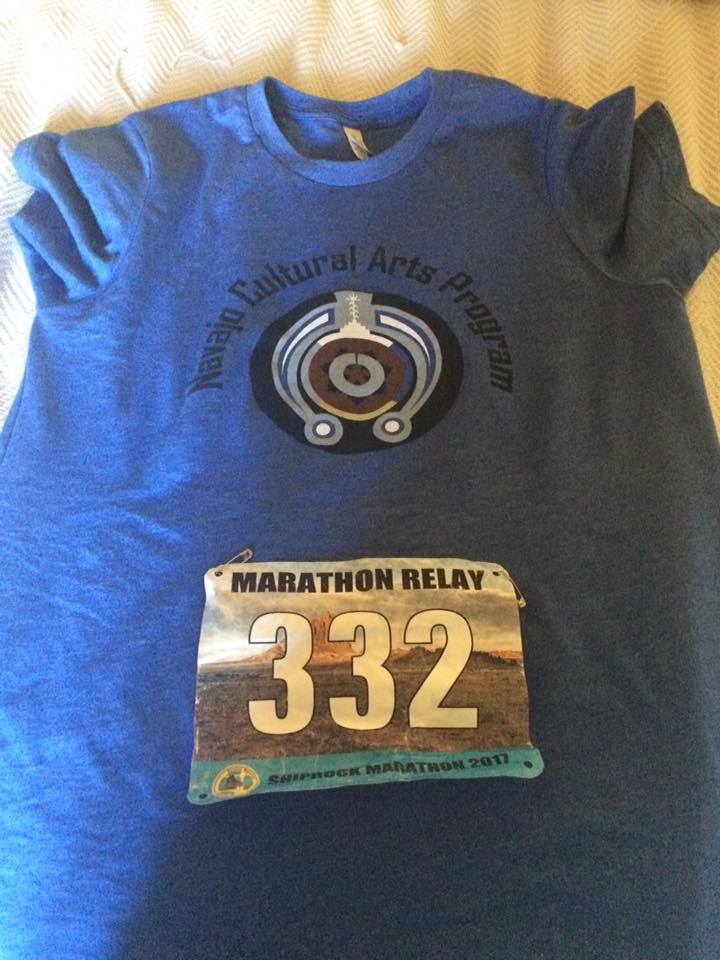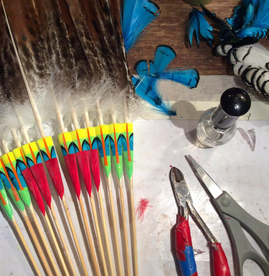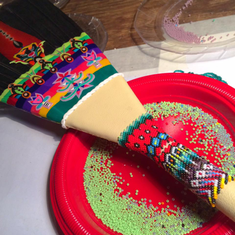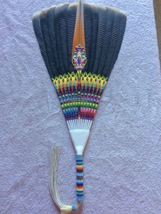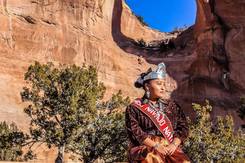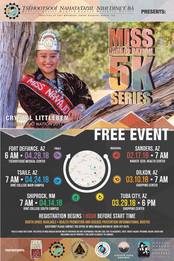Christine Ami Grant Manager, Navajo Cultural Arts Program
in her blog "Leading with Fire" have always been inherently found in the practice of the cultural arts. Personally, weaving has helped to make me a stronger individual, and I would go as far as to say a tougher Diné woman. It was a treatment plan for my bouts with insomnia, depression, and writing blocks. Weaving also held the responsibilities of a teacher, showing me how to engage my cultural belief system and fortify my critical inquiry skills and self-esteem. Throughout my time as the NCAP grant manager I have learned that cultural arts holistic well-being is an area that many of our Emerging Artisans are trying to not only fully comprehend but also to embrace. "Where do we start?" many ask as they entered the Navajo Cultural Arts Certificate Program. My response is always the same - Just do it - Work with raw materials, talk with the plants, put your scraps away properly, make mistakes and learn from them. I tell them to take care of those teachings and the many others that they will learn along the way because, as cliché as it sounds - if you take care of them, they will take care of you. With those inquisitive artisans in mind, I thought I would take a minute to address the NCAP's take on Holistic Well-Being, specifically focusing in on how artisans can start to reflect upon their work from a holistic perspective. While there have been several pieces about holistic well-being published, one article in particular stood out to our NCAP team: "The Wellness Wheel: An Aboriginal Contribution to Social Work" by Dr. Margot Loiselle and Lauretta McKenzie. What we specifically liked about this article was 1) its adaptability to indigenous paradigms; 2) its dialogue with Diné holistic well-being; 3) its encouragement to self-assess; and 4) its proposed wellness program through an analysis of four aspects: Physical/Material Aspects, Emotional/Social/Relational Aspects, Mental/Intellectual/Cognitive Aspects, and Spiritual/Ethical/Cultural Aspects. Loiselle and McKenzie created a list of guiding questions that could be used to assess an individual's well-being. NCAP critically analyzed those guiding questions to understanding how they could be adapted to further inquire into the Navajo cultural arts holistic well-being. The following are guiding questions that artisans can utilize to self-assess where they are in terms of their own cultural arts holistic well-being journey. Physical / Material Aspects:
Mental / Intellectual / Cognitive Aspects:
Spiritual / Ethical / Cultural Aspects:
These are in no means an ends to Navajo cultural arts holistic well-being; however, they have been a starting point of discussion as we worked with several Navajo cultural artisans throughout this blog series. In call a particular we would love to give a tremendous shout out and thanks to Kurtis Smith, Shayne Ray Watson, Sharonna Rae Yazzie, Sam Slater, Leonard Gene, Waycee Harvey, Troy Uentillie and Jess Williams, for helping us to gather a little further insight into the holistic well-being of Diné cultural artisans. Ahee'hee!
And for artisans who wish to create what Loiselle and McKenzie call a "self-care plan", these guiding questions may be able to help set positive goals, identify negative behaviors, and look toward creating a more holistic approach to their cultural art well-being. Stop by next week for our final blog of the series, which will include an analysis of the series' findings as well as an announcement by Miss Navajo, Crystal Littleben detailing our Summer Weekend Workshop Series!
1 Comment
Johnnie Bia, Jr. Diné College Psychology BA Intern, Office of Miss Navajo Nation
School back in 2002 and he also took some credits with Dine College before he transferred down to Phoenix Valley where he went to Scottsdale Culinary Institute- Le Cordon Bleu. He resides in Phoenix Valley nowadays where he is an Executive Chef. Kurtis was first curious about how people made ceremonial blankets when he would attend NAC peyote ceremonies. He then finally took it upon himself to learn how to sew. From the encouragement of one of his good brothers, he was able to learn how to sew with a sewing machine. His first projects were for a giveaway items for his little sister’s peyote ceremony.
material/colors and how the customer wants their product to function. Kurtis feels that he is at an “Okay” level for his sewing skills and techniques because he believes that you cannot judge your own self on your work. But he does stress that he puts his whole self into his work, reminding others that you have to take care of yourself first - be in a good physical state and good mindset. If there is something wrong with you or not feeling good, it will be difficult to fold or to sew. People don't want individuals who are falling apart to create their pieces just like they don't want your blankets or bags to be falling apart - people can judge you for that so put in your best efforts. You are the first one that needs to be healthy before you start working on a project. You want your customer to feel good and to take care of your products
through their schedule. Kurtis mentioned that he takes care of his sewing abilities because it was given and he has been blessed with it. Once you figure it out and master it, just take good care of it. Sometimes it works in your favor and sometimes it difficult to work through problems that pop up. Either way, it is something you can’t just give it away or push it off to the side because it is a part of your livelihood. You put your mind into it, you made it a part of yourself. The designs and colors you put on the projects is a part of you. A person must give themselves to that gift that was given to them. There’s good thoughts, prayers, and songs that go into it, a person will have some teachings from it. He/she can make a good living with it, whatever they want they can obtain it through sewing.
Sewing can build up your self-esteem and self-worth by seeing the happy faces of your customers. You feel proud and good within yourself when you know that people are amazed from your blankets & bags. They feel thankful and happy about your work so when they Thank You, it moves or touches your mind, heart, and soul. Sewing can give and take relationships with family, friends and relatives. When working on a blanket or bag, you are using and sacrificing your time away from family, friends, and relatives. It helps to maintain a good relationship by setting a good example of knowing how to sew a ceremonial blankets and bags. It can be good and bad depending on how your family, friends, and relatives take it. For Kurtis, sewing holds a significant and spiritual place in his life - putting himself out there for self-preservation, self-deaeration and away from self-destruction. He found something that he could put spiritual value into so that he wouldn’t harm himself or anybody else. For Kurtis, he wants to live a good life through his sewing, it can put a person in check and can leave them in a good place. Your relationships are based on what you put out for people. Sewing blankets and bags coincides with that output of his values, beliefs, and values. Kurtis takes time for prayer by finding it is best that a person should be in a clear mind, in a state of trancendency when dealing with spiritual instruments. Kurtis listens to peyote music because it helps a person to keep going as they work on a project. Singing along with the music while folding or sewing is always good to do because it helps you to get into it. By doing that, it’s a prayer in a song that goes along with and within a blanket and bag. Kurtis mentions the positive activities that a person can do for their spiritual well-being is knowing that it has to be you, “Taa’hwiajitee’”. Praying is the main thing that a person can do for themselves. You can give someone money to help say a prayer for you, but what if things don’t go your way. It will be easy to blame that person for nothing saying a right prayer for you. So it is best to pray for yourself, because that will help you to believe it by saying those words that come out of your mouth. Praying is the only and best way to keep your spiritual-self going. In conclusion, there are a lot of things that go into folding and sewing Native American Church peyote blankets and bags. Being in good physical health within a person is important, because they have to be up to doing the work. Having a clear and positive mind helps a person to really get into folding and sewing. It helps an artist feel good emotionally through the customer’s reactions of the final completed product. The spiritual aspect is the main important one to focus on because people are going to be using the blankets and bags around a peyote ceremony. In a way an artist must be in a spiritual mindset, spiritual feeling, and to live that spiritual lifestyle. It is having respect for the gift of folding and sewing blankets and bags.
From the Three Tiered Navajo Skirts to Contemporary Sewing: Holistic Well-being Through Dress Making4/24/2018 Johnnie Bia, Jr. Diné College Psychology BA Intern, Office of Miss Navajo Nation
the three tiers of the skirt that trace our Diné women's journey through their childhood, adulthood, and elderly years. And as of late, we have seen a rise in contemporary takes of this style walk the fashion run ways from Arizona to New York to Europe. Despite its travels, the Navajo tailors and seamstresses continue to root themselves in the cultural nuances of this cultural arts practice. I am in no way close to a tailor, but I do know someone who is!
and old style pleats on the bust, the back, and the sleeves of each blouse. Shayne’s strategic plan to attaining success in his future with sewing is built around a self-owned small company. So in the future hiring staff will be beneficial. Together they could maybe triple or quadruple their work and their earnings each day rather than one person making one garment and finishing it for the next 2 to 3 days. Sewing contributes to his overall physical health. He explained - you are always on your feet, always having your hand gestures move softly, quickly, steadily, and constantly. Some positive activities outside of the act of sewing that can enhance your work is eating healthy. Through proper nutrition you make sure you get your vitamins, water intake, and also protein intake with fruits and other organic items. One unique aspect that Shayne brought up was keeping up with your hygiene as another way to improve your work - when you are working, showering at least twice a day, one in the morning when you get up and then always one at night before you sleep is important. You may think this is a lot of showering but... because you don’t know what chemicals and fibers are on each fabric, its better to shower after each project for your health.
Shayne is satisfied of what he does because he can actually create an item or garment for someone who cannot create it themselves. But each piece is so unique that it brings to them a unique feeling of having something created just for them.
Meditation also helps positively build your mental health, not only during the project but also before. Mediation is your quiet time, where you can actually think clearly and prepare yourself for your next garment order. It also helps you to trouble shoot any issues that you may have run into. From a spiritual perspective, Shayne learned his sewing techniques from his great grandmother and he will always be able to take those teachings with him wherever he goes. In this way, what he sews not only connects him to his grandmother but he also extends his grandmother's teachings to those who receive his work. In addition to the connections to his grandmother, Shayne feels a sense of connectedness and pride for the value of Navajo culture. In doing his work and creating new garment, he always has tied his beliefs into Navajo culture and history because that is how he creates his garments and designs. For these reasons, he is actually creating work that coincides with tradition - from old style traditional wear to contemporary and modern wear. Finally, he also points out that prayer is also something that you can do while you are in the midst of your sewing because that’ll help you so many ways. Prayers gives you more spirit and sets your mind in your current sewing task. In conclusion, as a tailor or a seamstress, you impact both your own holistic well-being and that of the clients or recipients of the clothes you make. This makes perfect sense to me - I know how I feel when I put on a freshly pressed shirt made especially for me. It makes me stand just a few centimeters taller and feel just a bit more confident. We have come a long way since our days of loinclothes and rug dresses, but our clothing today and sewing of those clothes utilize many of those skills and techniques that help to reconnect us to our Dine holistic self. Thanks, Shayne, for all your insight! And stay tuned, blog readers, Miss Navajo will be hosting a skirt making workshop this summer as part of her Cultural Arts Holistic Well-Being Workshop Series :)
If you are just now joining our blog series, please take some time to review some of the past Holistic Well-Being blogs from this 10 - week series! Johnnie Bia, Jr. Diné College Psychology BA Intern, Office of Miss Navajo Nation
Sharonna is Coyote Pass clan, born for the Mexican People clan, her maternal grandmother is Bitter Water clan, and paternal grandmother is of the Red Bottom People clan. She is originally from Lukachukai, AZ. She is 24 years young. She recently received a Business Administration BA from Diné College. She is the Office Manager the Diné College Office of Institutional Planning and Research. Both of Sharonna's grandmothers weave and she feels extremely fortunate to be the only grandchild who can weave on both sides her family. Her paternal grandmother weaves the Yeii bi Cheii’s designs and had to have a ceremony that would give her permission to weave this sacred pattern. As for her maternal grandmother, she weaves two-faced rugs. Those rugs have one image on the font and another image on the back.
I asked Sharonna about some of the physical activities outside of weaving that directly enhances her cultural arts work. She shared that sleep, good posture, and home tidiness are most important. Sitting to long makes a person slouch when their progressing upward with my rug and it ruins a person’s posture so it would be nice to have some chair or cushion that will help them on their posture. Economically, Sharonna does not sell her rugs but there are many individuals who do sell their creations. When other artists sell their rugs, the money is used to purchase more tools or to help the person get by with life. Within the Navajo Nation there are those who make weaving as a career because it is the only income that they receive. The NCAP cohort watched a documentary called "Weaving Worlds" to explore the complexities of Western and Traditional concepts and practices of selling rugs.
Sharonna also talked about how making cultural arts products contributes to her mental stimulation. She envisions the rug before it takes shape and that planning helps to guide her wool. But that doesn't mean that the rug will turn out like her original plan. Many of her creations would just come to her or they would be changing and making their own image until completion. So she learned to be flexible and listen to the design. Two positive things that can enhance both mental and cultural arts well-being are 1) knowing how to manage your time and 2) getting information and strategies about weaving before your start. So deadlines and strategic planning are necessary especially as she does plan on making her own dresses and blankets designs in the future. In the meantime, she has plans to improving her one sided rugs and exploring ways on how to get two different pictorial images on a double sided rug. These tests keep her mind constantly moving, anticipating problems, and strategizing how to overcome those problems.
solid colors but there is always that one color that she picks to stand out more than others, and her designs are steps with images which tells a story of her life when she would start from bottom. She takes time for prayer, fasting, meditation, and enjoyment of her creation processes. There are certain songs that are used for weaving when starting and as you are weaving. For Sharonna, she only know two songs. When she sings and weaves, her rug grows faster and it is straight with no mistakes. Upon completion she thanks the creator and her grandparents on what they taught her, and also for helping her on getting the rug done and not having her lose herself in the process. She knows some stories about rug weaving, to her understanding there are so many stories that apply to the rug and its process from making the wool and taking the rug down. The positive activities she does to nurture her spiritual life and cultural arts practices are following what she believes in without thinking about it failing, or without having anything get in the way of her ethical values. In conclusion, weaving has been in our history through Traditional prayers, songs, and stories. It goes along with our way of life through the sheep we have, how we take care of our sheep, and how we use the wool off the sheep. It teaches us how to make our Navajo people be creative in their own way, incorporating spiritual aspects. Our hope is that Navajo Rug Weaving will continue to flourish among our Navajo people as we continue to move forward in today’s generation. If you have time April 13-20, stop by the NHC Museum at Diné College to check out the variety of weavings created by our NCAP Emerging Artisans for our 2018 Navajo Cultural Arts Exhibit. We will have 25 pieces of textile, silverwork, basketry, and leatherwork on display - all vying for best of show. Don't forget to vote for your favorite exhibit entry - winner will be selected as the "Community Choice Award"!!!!
Crystal Littleben Miss Navajo 2017-2018, Office of Miss Navajo Nation
workshop as well! My moccasins were an inch too long due to wear and tear (probably from the rainy and muddy days) and the wrappings were hanging by a tread! With help from former NCAPer and awesome workshop leader, Sam, the repair (surgery) was successful! I cut half an inch off the sole and restitched the back half. The stitching naturally came back to me and it was like I never stopped making moccasins. This experience helped to jump start my critical thinking about the holistic components of moccasin making - so that's what I have for you today!
crucial so that your moccasins seems don't have scalloped, wavy edges. This spacing is created through your diligent perception. So take time to rest your eyes. It pays of in the end. Your posture is also something that you have to pay attention to. Much like weaving, if your posture is poor, that laziness reflects in your work and back pain. Now mind you, this is just with the assemblage process. If you hunt, butcher and tan for your own buckskin - that's going to add a whole list of other physical demands as well.
Sam Slater also explained this connection between identity and moccasin making rather pointedly after the UNM workshop: "My identity as an individual is so tied to this art, it was such a humbling experience to teach it once again. Over four days of sharing and living moccasin stories, I know each of these participants all have their own moccasin story to tell, a story they stitched themselves". In short, as my yáázh Wilson Aronilth says, if you do not know who you are, you can never truly be happy. Knowing you are a moccasin maker for cultural artisans like Sam brings happiness and grounding in our Diné cultural identity.
of critical consciousness for your students, but often feel you’re missing the tools. These sacred shoes of survival are those tools. That’s all I have to say now, that these kélchí and their beautiful makers are such powerful tools for our people. I’m grateful for all they continue to teach me." In my opinion - becoming a moccasin maker is like getting your Ph.D. is Critical Theory and Application.
those who are no longer with us. It is in this way that moccasin making comfortably connects Sam and I. My aunt was known for making moccasins with a unique double stitch. Sam found out about this stitch from his NCAC Moccasin Instructor, Harry Walters, and started to experiment on his own. The double stitch calms the scallops of the sole and as Sam worked on mastering this stitch, in a way he smoothed my soul, pushing memories of my bizhi to the forefront. It must be a Round Rock thing! Thank you to NAS UNM and Sam for inviting me! Keep up the great work! And to our blog readers - if you want to give moccasin making a try - NCAP is hosting a mini moc workshop hosted by Aaron Begay, along with other cultural arts emphasis workshops during the 2018 Navajo Cultural Arts Week. Contact Christine or Sheryl to reserve your spot - They fill up quickly. Next week's blog is by Johnnie on the holistic components of weaving --- so stay tuned!!
Johnnie Bia, Jr. Diné College Psychology BA Intern, Office of Miss Navajo Nation
As I look into the Diné holistic components of Navajo silversmithing, I reached out to Master Silversmith, Leonard Gene and Emerging Silversmith, Waycee Harvey for some guidance. Leonard is Tó'aheedli'inii, born for Bit’ahnii, his maternal grandfathers are Ashii'hi, and his paternal grandfathers are Hashk'a'a i Hadzohí. He is originally from Rock Point, AZ. Waycee is Tachinii, born for Kinyaa'áanii, his maternal grandfathers are Todichinii, and paternal grandfathers are Tlaashchii. He is originally from Many Farms, AZ. He is apart of the 2017-2018 NCAP cohort and learning silversmithing from Don Denetdeal and Wilson Aronilth, Jr. I also took advantage of revisiting previous blogs written by former NCAPers, Delia Wauneka and Carlon Ami, to understand how the process of silversmithing makes us holistically unique.
frame, scribe, saw blades, files, acetylene tank, pliers, and creativity. This was the shopping list that was given to Waycee when he first started learning how to silversmith. From that basic tool kit, a silversmith can build up their supplies depending on the specialization they select (or I could also say the specialization that selects them). Specializations can include everything from stamping, overlay, in-lay, lapidary work, sand casting, tufa casting, and so forth.
feeling to the silversmith too - particularly when you finish a project to your liking. Delia also explored this elation in her blog "Wauneka's Meldown." On a NCAP trip to Meltdown Studios, Delia challenged herself to learn different techniques like chemical and electric etching. She also desperately wanted to learn how to make her own beads. It was somewhat of an emotional roller coaster: "I watched as Lauren did her demonstration, yet I struggled with this project and I decided to put it aside. Later on the day, I confronted my own self-doubts and challenged myself to finish one bead. You know what… I did it! I am so proud that now I can say, 'I made my own bead'". Delia explained that her self doubts were over come by her persistence. This is what Leonard must have meant when he reminded me that when you complete a project, it uplifts your spirit and makes you respect yourself for what you have done.
toughness you have to have. Carlon also wrote of this toughness in his blog "Just Take It Apart and Put It Back Together": "Don't let convention limit you. If you can reasonably imagine it, you might be able to build it. If it doesn't work out, you can always melt it down later for casting material." At the end of the process, there is a sense of satisfaction for completing the puzzle and having your ideas all come together. But the mental challenges don't stop there. When your done buffing and publishing, Leonard explained, there is a motivation released that inspires you to make improvements on the next project.
gives you another level of respect about what our culture means. With this understanding, you can have prayers done every now and then to help your work along and to keep you strong so you can continue your work with positive motivations. You can also sing songs while you’re working. It helps to stay connected with our traditional culture and values. After speaking with Leonard and Waycee, reconnecting with Carlon and Delia's blogs, and sitting in on some of the NCAP silversmithing classes, I can begin to understand how silver work helps an individual’s holistic well-being. There are physical demands when working with silver, sacred stones and minerals but you get energy, stamina, and motivation from them as well. Silversmithing is an emotional journey, bringing joy to you and others when your work is completed, even amidst the self-doubt and frustration during the process. This cultural art helps your mind to focus on the positive, which in turn, helps maintain creativity within your work. Ultimately, silversmithing as a Diné individual evokes a spiritual feeling through the stories and history of how Navajo people have always had silver and the sacred stones. Silversmithing has many benefits for a person who wants to learn. It will give you as much as you want to give to it.
And with that said...
Christine AmiGrant Manager, Navajo Cultural Arts Program
Currently, I am working along side Crystal from Office of Miss Navajo Nation and Johnnie from the Diné College Psychology Program on this unique Navajo Cultural Arts Holistic Well-Being Blog Series. While Crystal and Johnnie are focusing on specific emphasis areas and their relationship to the cultural arts, I'll be posting on NCAP's perspectives of holistic well-being as well as ways for artisans to self reflect on how they can utilize a holistic approach in their own work. This week I'll be looking at our NCAP Logo and how it dialogues with Crystal's platform and Johnnie's research. The NCAP logo was collaboratively created by graphic artist, Corey Begay, and the NCAP staff. We contacted Corey because of his work with Salina Bookshelf, Inc. and the reputation he created through his mural projects in Flagstaff. We were in search of a logo that embodied our mission - to enhance and revitalize traditional Navajo cultural arts practices while promoting intergenerational teachings. We wanted something recognizable that also emphasized the cultural arts specializations offered in our Certificate Program: weaving, silversmithing, moccasin making, and basketry. Corey was up for the challenge and sent us a few sketches. We selected one of his ideas that interwove elements of beauty and protection. His ideas meshed so well with our own that we could see the potential of the Program through his sketches. From that draft, Corey consulted Diné individuals and the NCAP staff brought in suggestions from the Center of Diné Studies' faculty members. This is what was created!
Within the elements of the logo exists a ring of colors. These colors are not meant as a kitschy approach to culture nor is it a Panindian understanding of wellness. They are Diné philosophies encapsulated within our sacred stones - yoolgai, dootl'izhii, diichilí, dóó bááshzhinii. The NCAP understands them as the ontological (yoolgai - white shell), epistemological (dootl'izhii - turquoise), methodological (diichilí - abolone shell), and ethical (bááshzhinii - black jet) approaches to surviving this world in a balanced manner. These stones are at the base of the Diné holistic well-being framework presented by Crystal. When we work with these stones, we pull to us the physical health, emotional health, mental health, and spiritual health from which they stem. And when we work on our holistic well-being, we call upon these stones for guidance. This is how the relationship between the stones and well-being are reciprocal.
If you enjoyed this quick read today or for more information about the cultural arts and Diné holistic well-being, don't forget to..... -Visit Miss Navajo Nation's website and her next 5K run in Tuba City -Check-in with the NCAP blog - Next week's blog is on silversmithing! -Apply for the 2018/2019 Navajo Cultural Arts Certificate Program :) Johnnie Bia, Jr. Diné College Psychology BA Intern, Office of Miss Navajo Nation Ya’at’eeh. My name is Johnnie E. Bia Jr. My clans are Totshonii (Big Water) clan, born for Ma’iideeshgizhnii (Coyote Pass) clan, my maternal grandfathers are Hoonaghanii (One Who Walks Around) clan, my paternal grandfathers are Todichinii (Bitter Water) clan. I am originally from Dilkon, AZ, but I grew up at Canyon De Chelly. At Diné College, I am a Psychology BA student as well as as a Peer Mentor to Freshmen and Transfer students. As a part of my Internship for my Field Work Experience Course, I am working with Miss Navajo Nation 2017/18, Crystal Littleben to research the connections between Diné Holistic Well-being teachings and the Navajo cultural arts. This means that I am exploring how cultural arts help Diné people to improve themselves on physical, emotional, mental and spiritual levels. This week I am focused on how Native American Church Peyote Ceremonial Fans help and heal an individual from a holistic perspective. To do so, I reached out to some friends and fan makers, Troy Uentillie and Jess Williams, in addition to my own experience making fans to help me better understand and explain this connection.
But in addition to the monetary costs, the fan makers see this caution and awareness as it applies to our everyday - we have to be aware of our surroundings and the people we have around us. We can’t just trust anybody with the fan that we make because we put a part of ourselves into it. In this manner, and perhaps more importantly than the monetary costs, fan making teaches the maker to take care of themselves when we are working with feathers and beads. We have to eat the right kind of foods, and we have to take a break and move around from time to time. Otherwise it can get to our back and shoulders if we tend to sit there for long periods of time. That tension comes out in our work.
Working on feathers and beads also helps to occupy and train the mind to the control your creative powers as you learn how to work with different colors and supplies to make these fans beautiful. But aesthetics aren't the only thing because you are putting your time and effort into something more powerful than looks. Instead of being somewhere else and getting into other things that are not good for you, the fan makers find themselves creating a tool for prayer. Fan making also helps you to be organized and maintain cleanliness with our supplies and feathers. Most of the time working with feathers and beads can get messy but with diligence, you learn to keep your work area and things in order. Otherwise, you will be misplacing things all the time, creating a chaos of the mind.
Another significant thing about working on fans is having the motivation to do the bead work and feather work. A person has to be feeling up to it and wanting to work on these things. They cannot be forcing themselves to do work on these things. If you force it, it will not turn out they right way. On the other hand, fan making allows for the maker to find happiness when they are complete with their projects, especially when the rightful owner sees it. The owner's happiness only builds to the makers own sense of happiness from how the fan turned out. In a spiritual sense, these NAC ceremonial fans are not just something to mess around with - they all have a spirit within them. A person has to know protocols and stories when working with feathers from certain birds. Some of these birds have their own way and their feathers are living. No one truly knows what kind of power they have. For this reason, it is always helpful to ask someone such as a Roadmen, Medicine Men, Elders, and other people who know specifics about these ceremonial items. These NAC fans will be used around ceremonial settings and the fan maker must keep that in mind while making them. While there is a sense of pride when you are able to pray and utilize
If you are interested - NCAP and the OMNN will be co-sponsoring a Feather Tying Workshop this summer as part of our Summer Weekend Workshop Series led by Troy Uentillie - so stay tuned! For more information about Diné Holistic Well-being, please visit Miss Navajo Nation Crystal Littleben’s website, her blog "Leading with Fire: Navajo Cultural Arts and Holistic Well-Being," and the NCAP blog!
Crystal Littleben Miss Navajo 2017-2018, Office of Miss Navajo Nation
I graduated with at B.A. in Psychology from of Northern Arizona University with a minor in Native American Studies. After my reign, I do plan to return to NCAP as the Project Coordinator to continue my work, educating our Navajo people about our cultural arts and language. But in the meantime - during my reign - I have been afforded the opportunity to bring my personal, professional, and educational experiences to the forefront through my pageant platform - improving the holistic well-being of Navajo communities through Navajo cultural arts, stories, and language. Before addressing some of my current and future reign projects, I wanted to take a moment to explain my understanding of Diné holistic well-being.
Preparing for the Miss Navajo Nation Pageant tested my abilities to follow this model and now I am implementing it as a pathway to holistic well-being for my reign. Starting in the east with our physical well-being, the Office of Miss Navajo Nation is building momentum as we continue working with and improving our emotional well-being in the south, mental well-being in the west, and spiritual well-being in the north.
The Miss Navajo 5K series shares their mission - that running can strengthen our Indigenous communities - and emphasizes that running can better themselves from physical, emotional, mental, and spiritual perspectives. The Diné women’s puberty ceremony, for example, challenges our young women to run towards the east every morning as an act of physical endurance, emotional balance, mental strength, and spiritual connection. The participants of the Miss Navajo 5K series are asked to face these same challenges during their runs. Even in the manner that the runs have been planned out took into account the holistic geography. Beginning in an Eastern location (Sanders), the runs will follow circular path around the Navajo Nation (Dilkon, Tuba City, Shiprock, Tsaile, and Fort Defiance). Following this model, younger generations can experience how our well-being is interconnected within this framework and helps us remain in balance with ourselves and the physical and spiritual worlds.
I first became aware of these components as I picked up the art of silversmithing when I joined NCAP. Taking workshops and classes, I had to connect to my physical, emotional, mental, and spiritual self in order to learn and practice with traditional stones, wool, tools, and designs. I found that when one was out of balance, I had difficulties concentrating, my designs wouldn't come quickly, and my work was rough and required extra filing. Some of my stressors included school pressures, family struggles, personal challenges, and even worrying about my puppies. Once I stopped avoiding my stressors and addressed those issues head on with the purpose of finding a solution, my work was directly impacted in a positive fashion. I gained confidence not only as silversmith but also as a Diné woman. While I understand that these pieces can be created without the cultural connections, I am seeking to better understand and support a holistic approach to the cultural arts. In collaboration with the NCAP, the OMNN has created this Navajo Cultural Arts Holistic Well-Being Blog Series to showcase the importance of my platform. Over the next 6 weeks, we plan to release a blog that addresses one cultural arts emphasis and its holistic components each week. With help from the Diné College Psychology Bachelor of Arts Program, I have gained a PSY B.A. intern, Mr. Johnnie Bia, who has expressed an interest in learning more about Navajo Holistic Healing and the application of holistic healing in efforts that promote well-being. Mr. Bia will also be able to showcase the knowledge he learns through his hands on research by attending events hosted by Miss Navajo Nation and the NCAP. As a deliverable, Mr. Bia will share his experiences and newfound research through this Navajo Cultural Arts Holistic Well-Being Blog Series. This summer, as our crops are growing, I will be conducting a Summer Weekend Workshop Series across the Navajo Nation with the NCAP to lead my community through holistic well-being model with cultural arts. More information will become available for these community-based workshops - Stay tuned!
|
Categories
All
Archives
October 2021
|
||||||||||||||||||||||||||||||||||||||||||||||||||||||||||||||||||||||||||||||
SocialsALL PHOTOS IMAGES ARE COPYRIGHT PROTECTED. PHOTO IMAGES USE IS SUBJECT TO PERMISSION BY THE NAVAJO CULTURAL ARTS PROGRAM. NO FORM OF REPRODUCTION IS PERMITTED WITHOUT WRITTEN PERMISSION FROM THE NAVAJO CULTURAL ARTS PROGRAM. |
Featured Pages |

